Catholic Customs
 |
 |
 |
 |
 |
 |
 |
The ‘Biddy Boys’ & Woven Crosses
of St. Brigid’s Day
The people of Ireland have a special devotion to all of the Saints of their Emerald Isle. St. Patrick is, of course, the best known Irish Saint outside of Ireland, but in Ireland St. Brigid is equally honored and loved on her feast day February 1st as the Joint Patron of that country.
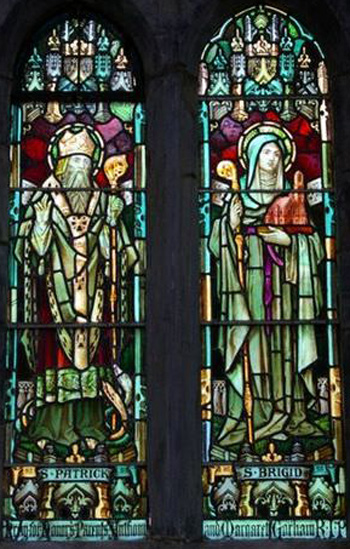 Born near the end of St. Patrick's life, she is believed to have known Ireland's Apostle, as it is written in the Trias Thaumaturga: "Between St. Patrick and St. Brigid, the columns of the Irish, there was so great a friendship of charity that they had but one heart and one mind. Through him and through her Christ performed many miracles." (1)
Born near the end of St. Patrick's life, she is believed to have known Ireland's Apostle, as it is written in the Trias Thaumaturga: "Between St. Patrick and St. Brigid, the columns of the Irish, there was so great a friendship of charity that they had but one heart and one mind. Through him and through her Christ performed many miracles." (1)
In A.D. 450, Brigid was born of a pagan chieftain father, Dubthach, and a Christian slave mother. Her greatness was prophesied as she was in her mother's womb by both a Catholic Bishop and a Druid of Dubthach's household. The Druid predicted that there would be a babe born who "shall be called from her great virtues the truly pious Brigid; she will be another Mary, mother of the great Lord."
The life of St. Brigid demonstrates well the Irish spirit and the transition from Celtic paganism to Catholicism. St. Brigid founded the first convent in Ireland and a school of metallurgy and illumination that would deeply imbue the Irish culture with the Catholic spirit. Continuing the legacy of St. Patrick, her piety and miracles converted many Irish Druids.
It is beautiful how intertwined is the remembrance of St. Brigid with Mary. The Irish hold St. Brigid so dear in their hearts that they call her "The Mary of the Gaels" and a common greeting is "Brigid and Mary be with you." It shows us the simplicity and purity of the Irish soul that had a filial devotion to the Mother of God.
The ‘Biddy’ boys
There are many charming customs for St. Brigid's feast, February 1. Certainly Irish families could try to restore some to their family's liturgical year in the home. But, really, the customs of St. Brigid have a universal appeal and the whole Catholic world can be a bit Irish on St. Brigid's day.
The Irish women prepared for St. Brigid's feast day days before by cleaning their houses – a grand winter Irish cleaning! The wealthier farmers would give butter, buttermilk and lamb to poorer families in honor of Brigid's great generosity.
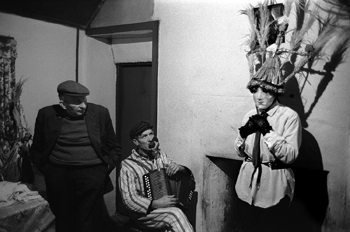
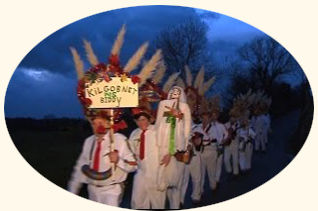 The young girls and women of the village would often meet to make an effigy of St. Brigid known as the Biddy or Brídeóg. This effigy could be either life-sized or doll-sized, the body made of straw, rags or, most traditionally, a butter churn.
The young girls and women of the village would often meet to make an effigy of St. Brigid known as the Biddy or Brídeóg. This effigy could be either life-sized or doll-sized, the body made of straw, rags or, most traditionally, a butter churn.
On the eve of her feast, the Irish wives bake spiced breads known as Bairn brack. Then, in every neighborhood the Irish folk would gather for a festive time of merriment in honor of their dear Brigid.
While the wives baked the bread, the young men disguised themselves in old clothing or garments or their own clothes worn inside out along with veils, masks and hats to hide their identity.
These groups of men, Biddy Boys, would parade from door to door carrying the Biddy doll, playing songs on their traditional instruments, dancing and singing. The leader of the group, who had the honor to carry the effigy of Brigid (the Biddy), would ask the master or mistress of each house where they stopped for money and sweets. When the door to the house opened, the young men would sing this rhyme:
In some places, young women would also go from door to door carrying their handmade Biddy dolls and asking for sweets, but in most regions this tradition was left to the men.
Weaving the St. Brigid's Cross
Another custom worthy of revival is the weaving of St. Brigid's Crosses from reeds, straw or rushes. It was inspired by a miracle of St. Brigid: the conversion of a pagan chieftain who was on his death bed. As Brigid made her way to visit the chieftain, she began to weave some reeds together in the form of a cross. The curious object evoked questions from the chieftain. She then commenced to explain the truths of the Holy Faith. The chieftain was so touched by the story of the Cross that he asked for Baptism.
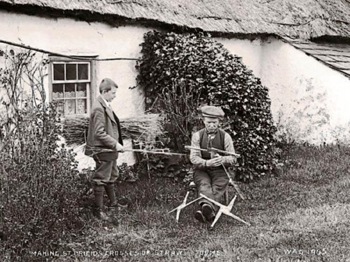
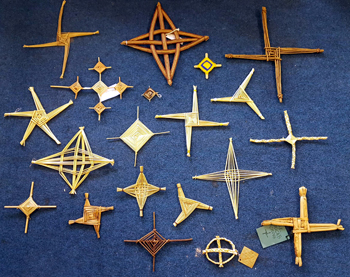 To commemorate this conversion the Irish used to weave crosses out of reeds to imitate St. Brigid. This was done with great solemnity in the past. On St. Brigid's Eve, one member of the family would collect reeds or straw and would lay them on the door step, with the hope that St. Brigid would come and kneel on these reeds to bless them and the house.
To commemorate this conversion the Irish used to weave crosses out of reeds to imitate St. Brigid. This was done with great solemnity in the past. On St. Brigid's Eve, one member of the family would collect reeds or straw and would lay them on the door step, with the hope that St. Brigid would come and kneel on these reeds to bless them and the house.
As evening came, the same family member would go outside and knock three times, crying out to those inside, "Go down on your knees and let Holy Brigid enter." The answer was, "She is welcome; she is welcome." Then the father of the house would open the door and let 'St. Brigid' into the house. The reeds were then placed either on the hearth or under the meal pot of potatoes. After this ceremony, the family would commence the celebration enjoying their cakes, potatoes, bread and ale.
After the meal, everyone would weave the reeds into crosses and pray the Rosary to ask for blessings for the year. Any leftover reeds were saved and used to make rushlights that would be lit in honor of Brigid. The head of the house ceremoniously carried the cross to every window and door, saying at each stop, "St. Brigid, save us from all fever, famine and fire."
On the Feast Day itself, these crosses were blessed with holy water while reciting the following blessing: "May the blessing of God, Father, Son and Holy Ghost be on this Cross and on the place where it hangs and on everyone who looks on it."
Every Irish home used to have a St. Brigid's Cross hung on the front door all year. Every year on St. Brigid's day the old Cross would be reverently burned or buried to make way for the newly woven one. The Irish believe that these crosses bring many blessing including protection from lightning, fire, animal diseases and evil spirits.
Here is a charming poem about St. Brigid's cross written in 1735:
The Irish people believe that St. Brigid comes down from Heaven to walk on Irish soil on her Feast Day. So strong was this belief that young and old were sure to place an oatcake shaped in the form of a cross, a pad of butter and sheaf of corn or straw on their windowsills for St. Brigid and her red-eared white cow.
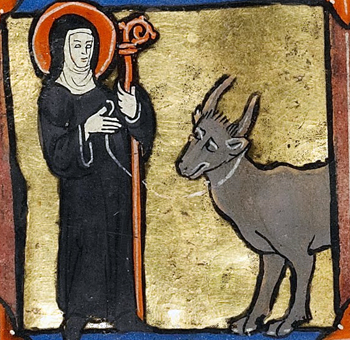 This custom derives from the legend that when Brigid was a baby, her mother, a slave, did not have sufficient milk to nurse her and a white red-eared cow – a rare beast – appeared to provide the needed milk.
This custom derives from the legend that when Brigid was a baby, her mother, a slave, did not have sufficient milk to nurse her and a white red-eared cow – a rare beast – appeared to provide the needed milk.
Laying out food, the Irish folk invoke the Saint not to ignore their houses as she passes through Ireland, giving her blessing to the people and livestock.
Such is their confidence in their dear patron that the Irish also hang handkerchiefs and ribbons on trees for Brigid to touch as she travels. These ribbons and handkerchiefs are called "St. Brigid's Mantle," cherished for their curative powers given to them by St. Brigid's blessing. They are even attached to men's hats and woven into sailor's mantles to ask for Brigid's protection on their perilous journeys.
Before going to sleep on St. Brigid's Eve, the head of the household would smother the ashes in the fire and smooth them in the hearth so as to catch the footprint of St. Brigid as she passed through the house.
Restoring the customs
The weaving of St. Brigid's Crosses on January 31 would be a fitting way to honor St. Brigid, especially if you are of some Irish decent. With all solemnity, a family member should collect reeds or straw and place them on the doorstep to prepare for the ceremony described above.
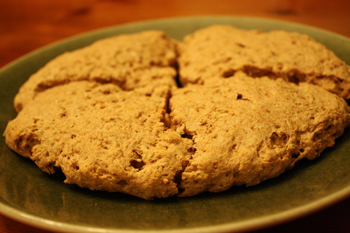 After 'St Brigid' enters and the crosses are woven, the festivity begins with a homey Irish feast consisting of
Boxty Cakes,
St. Brigid's Oatcakes, Barmbrack, and Colcannon. For instructions on how to make the St. Brigid's Cross, click
here.
After 'St Brigid' enters and the crosses are woven, the festivity begins with a homey Irish feast consisting of
Boxty Cakes,
St. Brigid's Oatcakes, Barmbrack, and Colcannon. For instructions on how to make the St. Brigid's Cross, click
here.
On February 1, her Feast Day, the crosses are blessed with holy water while the traditional blessing is said. The crosses hang over the doors of your house to honor St. Brigid and bring God's blessing on your household and family the whole year.
The rich Catholic culture that developed in Ireland since the time of St. Patrick and St. Brigid inspired many good customs. Restoring those customs is part of restoring Catholic culture. It also helps to bring a needed resurgence of devotion to the Saints and belief in the supernatural. Thus is the bridge between earth and Heaven rebuilt.
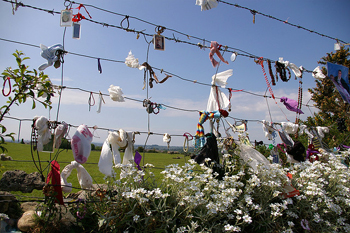

The patrons of the Emerald Isle
in St. Joseph Church, Cleften, Ireland
In A.D. 450, Brigid was born of a pagan chieftain father, Dubthach, and a Christian slave mother. Her greatness was prophesied as she was in her mother's womb by both a Catholic Bishop and a Druid of Dubthach's household. The Druid predicted that there would be a babe born who "shall be called from her great virtues the truly pious Brigid; she will be another Mary, mother of the great Lord."
The life of St. Brigid demonstrates well the Irish spirit and the transition from Celtic paganism to Catholicism. St. Brigid founded the first convent in Ireland and a school of metallurgy and illumination that would deeply imbue the Irish culture with the Catholic spirit. Continuing the legacy of St. Patrick, her piety and miracles converted many Irish Druids.
It is beautiful how intertwined is the remembrance of St. Brigid with Mary. The Irish hold St. Brigid so dear in their hearts that they call her "The Mary of the Gaels" and a common greeting is "Brigid and Mary be with you." It shows us the simplicity and purity of the Irish soul that had a filial devotion to the Mother of God.
The ‘Biddy’ boys
There are many charming customs for St. Brigid's feast, February 1. Certainly Irish families could try to restore some to their family's liturgical year in the home. But, really, the customs of St. Brigid have a universal appeal and the whole Catholic world can be a bit Irish on St. Brigid's day.
The Irish women prepared for St. Brigid's feast day days before by cleaning their houses – a grand winter Irish cleaning! The wealthier farmers would give butter, buttermilk and lamb to poorer families in honor of Brigid's great generosity.

The 'Biddy Boys' returning from their begging; below a more recent procession of 'Biddy boys'

On the eve of her feast, the Irish wives bake spiced breads known as Bairn brack. Then, in every neighborhood the Irish folk would gather for a festive time of merriment in honor of their dear Brigid.
While the wives baked the bread, the young men disguised themselves in old clothing or garments or their own clothes worn inside out along with veils, masks and hats to hide their identity.
These groups of men, Biddy Boys, would parade from door to door carrying the Biddy doll, playing songs on their traditional instruments, dancing and singing. The leader of the group, who had the honor to carry the effigy of Brigid (the Biddy), would ask the master or mistress of each house where they stopped for money and sweets. When the door to the house opened, the young men would sing this rhyme:
"Here comes Poor Brigid both deaf and blind.Giving an alms to the Biddy Boys was considered a serious obligation by every household in order to obtain St. Brigid's blessing and prosperity throughout the next year. The money the men collected was used to host a party with traditional dancing at the village dance hall.
Put your hand in your pocket and give her a coin.
If you haven't a penny, a half penny will do,
If you haven't a half penny, God bless you."
In some places, young women would also go from door to door carrying their handmade Biddy dolls and asking for sweets, but in most regions this tradition was left to the men.
Weaving the St. Brigid's Cross
Another custom worthy of revival is the weaving of St. Brigid's Crosses from reeds, straw or rushes. It was inspired by a miracle of St. Brigid: the conversion of a pagan chieftain who was on his death bed. As Brigid made her way to visit the chieftain, she began to weave some reeds together in the form of a cross. The curious object evoked questions from the chieftain. She then commenced to explain the truths of the Holy Faith. The chieftain was so touched by the story of the Cross that he asked for Baptism.

Irishmen weaving the traditional St. Brigid crosses, below crosses from different villages and counties

As evening came, the same family member would go outside and knock three times, crying out to those inside, "Go down on your knees and let Holy Brigid enter." The answer was, "She is welcome; she is welcome." Then the father of the house would open the door and let 'St. Brigid' into the house. The reeds were then placed either on the hearth or under the meal pot of potatoes. After this ceremony, the family would commence the celebration enjoying their cakes, potatoes, bread and ale.
After the meal, everyone would weave the reeds into crosses and pray the Rosary to ask for blessings for the year. Any leftover reeds were saved and used to make rushlights that would be lit in honor of Brigid. The head of the house ceremoniously carried the cross to every window and door, saying at each stop, "St. Brigid, save us from all fever, famine and fire."
On the Feast Day itself, these crosses were blessed with holy water while reciting the following blessing: "May the blessing of God, Father, Son and Holy Ghost be on this Cross and on the place where it hangs and on everyone who looks on it."
Every Irish home used to have a St. Brigid's Cross hung on the front door all year. Every year on St. Brigid's day the old Cross would be reverently burned or buried to make way for the newly woven one. The Irish believe that these crosses bring many blessing including protection from lightning, fire, animal diseases and evil spirits.
Here is a charming poem about St. Brigid's cross written in 1735:
“St Bridget’s cross hung over door,St. Brigid returns each feast day
Which did the house from fire secure;
O Gillo thought, O powerful charm,
To keep a house from taking harm;
And tho’ the dogs and servants slept,
By Bridget's care the house was kept.”
The Irish people believe that St. Brigid comes down from Heaven to walk on Irish soil on her Feast Day. So strong was this belief that young and old were sure to place an oatcake shaped in the form of a cross, a pad of butter and sheaf of corn or straw on their windowsills for St. Brigid and her red-eared white cow.

St Brigid, patroness of dairymaids & newborn babies
Laying out food, the Irish folk invoke the Saint not to ignore their houses as she passes through Ireland, giving her blessing to the people and livestock.
Such is their confidence in their dear patron that the Irish also hang handkerchiefs and ribbons on trees for Brigid to touch as she travels. These ribbons and handkerchiefs are called "St. Brigid's Mantle," cherished for their curative powers given to them by St. Brigid's blessing. They are even attached to men's hats and woven into sailor's mantles to ask for Brigid's protection on their perilous journeys.
Before going to sleep on St. Brigid's Eve, the head of the household would smother the ashes in the fire and smooth them in the hearth so as to catch the footprint of St. Brigid as she passed through the house.
Restoring the customs
The weaving of St. Brigid's Crosses on January 31 would be a fitting way to honor St. Brigid, especially if you are of some Irish decent. With all solemnity, a family member should collect reeds or straw and place them on the doorstep to prepare for the ceremony described above.

St Brigid oatcake with a cross in the center
On February 1, her Feast Day, the crosses are blessed with holy water while the traditional blessing is said. The crosses hang over the doors of your house to honor St. Brigid and bring God's blessing on your household and family the whole year.
The rich Catholic culture that developed in Ireland since the time of St. Patrick and St. Brigid inspired many good customs. Restoring those customs is part of restoring Catholic culture. It also helps to bring a needed resurgence of devotion to the Saints and belief in the supernatural. Thus is the bridge between earth and Heaven rebuilt.

Hankerchiefs and mantles for St. Brigid to bless
as she passes on her feastday
- A hagiography of the Irish saints, Saint Patrick, Brigid of Kildare, and St Columba, written by Franciscan monk John Colgan in the mid 1600s. Its title translates to the "Three Wonder-Working Saints"

Posted February 1, 2020
______________________
______________________
 |
 |
 |
 |
 |
 |


